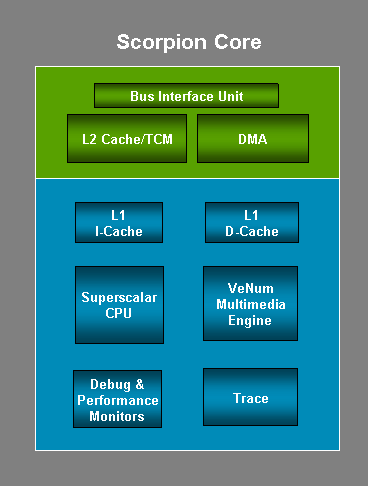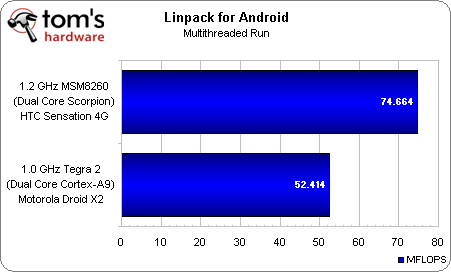HP TouchPad Review: A Tablet For Productivity?
Third-Generation Snapdragon: The Dual-Core Scorpion
As we’ve mentioned in the past, smartphones and tablets generally employ SoCs that integrate the processor, GPU, RAM, and several other subsystems in a single device. Since all of those components sit next to each other on the same chip, there is greater efficiency in data transfers, while reducing the amount of space consumed on the PCB.
Today’s SoC technology isn’t exclusive to each device vendor. The iPad 2 centers on Apple’s A5, while most Android-based tablets use Nvidia’s Tegra 2. And yet, both share a common RISC ISA by employing ARM’s dual-core Cortex-A9. Read Apple's iPad 2 Review: Tom's Goes Down The Tablet Rabbit Hole for a full discussion of Cortex-A8 and -A9 performance.
The APQ8060 powering HP's TouchPad is an almost-entirely different species. Despite its name, the APQ8060 is nearly the same as Qualcomm's MSM8260/MSM8660. The APQ prefix stands for Application Processor Qualcomm, and refers to a Snapdragon SoC that doesn’t include an integrated cellular modem. That critical differentiating component is part of the MSM (Mobile Station Modem)-designated Snapdragons, though. And that's why Snapdragons are a preferred choice amongst smartphone manufacturers looking for a single-chip solution.
The APQ8060 is a third-generation Snapdragon SoC. It shares a similar processor architecture with the A5 and the Tegra 2, but it's also slightly different. Instead of leveraging one of ARM’s reference designs, this processor is Qualcomm’s own creation, in use since the product's very first-generation incarnation. Dubbed Scorpion, Qualcomm claims its core is superior to the Cortex-A9 found in Apple's A5 and Nvidia's Tegra 2. Meanwhile, Nvidia claims Scorpion is closer to the Cortex-A8. The truth is somewhere in the middle.
Like the Cortex-A8, Scorpion has a dual-issue in-order architecture (some things can be done out-of-order), but that's where the similarities end. Scorpion is based on the same ARMv7 architecture found in the Cortex-A8 and -A9. However, according to the developer of Linpack for Android, Qualcomm’s design is supported by an array of 600 MHz DSP and accelerator cores for baseband and video processing that offer 128-bit single instruction, multiple data (SIMD) functionality. This means that it can process SIMD instruction in 128-bit wide chunks, whereas the Cortex-A8 and –A9 are restricted to 64-bit. The Scorpion also has a deeper pipeline (though how many stages is unknown), which includes VFPv3 (Vector Floating Point v3) commands not normally piped in Cortex-A8. Though, the new Cortex-A9 does implement a pipeline for VFPv3 commands. As Linpack is a measure of floating-point performance, Snapdragon-based devices will typically outclass their Cortex-A8 and -A9-based peers.
However, the real win for Qualcomm is actually in the power consumption department. The company claims 2.1 Dhrystone MIPS/MHz/core, whereas the Cortex-A8 is quoted at 2.0 DMIPS/MHz/core. Purportedly, the difference is that getting Cortex-A8 to its top speed depends on TSMC’s general-purpose fab process, whereas Scorpion uses low-power silicon. According to Berkley Design Technologies, the Scorpion consumes roughly 200 mW at 600 MHz (including leakage current, which is negligible in the low-power process). Compare that to the Cortex-A8, which consumes about 350 mW at 600 MHz manufactured at 65 nm.
Get Tom's Hardware's best news and in-depth reviews, straight to your inbox.
Current page: Third-Generation Snapdragon: The Dual-Core Scorpion
Prev Page The Developer's Dilemma Next Page The Adreno GPU: An AMD Bloodline-
obarthelemy I have faith in the QuickOffice port coming through: datawiz have been woking in the mobile space since Palm days (actually, they started on Palm I think, so they know their stuff, and the platform. It works well on Android.Reply -
obarthelemy I don't understand why you use the Xoom as the Android yardstick though, it's been upstaged long ago, by the Asus and Samsung tablets at leastReply -
compton I'm certainly glad the TouchPad has a decent display -- a good trend to say the least. Apple deserves much of the credit for setting the quality bar in consumer devices like the iPhone/iPad. Happily, if you are looking around for a new phone or tablet, good displays are easy to find. If consumers as a whole get used to using good screens in tablets/phones, why don't more laptop manufacturers capitalize by upping their game? HP may have realized that the TouchPad needs a good display, but most laptop (theirs, Dell's, Asus, ect.) displays are shamefully terrible. Perhaps the laptop as we know it needs an injection of what makes modern tablets so appealing -- and at (or around) the top of that list is a bitchin' screen.Reply -
I've probably read at least 20 reviews of the touchpad. This is the only one I would actually call a review. This was balanced and in-depth. Thank you for your efforts.Reply
The one thing lacking in this review, which is also lacking in everything being written about webos, is the mention of what I consider one of the standout features of webos: The openness of the platform. With preware installed (free), you have access to thousands of patches and homebrewed apps as well as linux applications. It is possible, for example, to run a full Debian Linux in a chrooted environment (without any cracking or jailbreaking), giving access to OpenOffice, and all other x-server Linux software out there. HP/Palm is the only tablet OS developer that actively encourages the homebrew/open source community in its efforts. As a developer, it is not only the ease of development that is compelling but the huge amount of expressive and creative freedom you get. With the Apple appstore, the walled garden may protect consumers well, but also creates a completely controlled and often repressive and capricious environment for a developer. This openness is the secret sauce behind much of the loyalty of webos users. The os is a joy to use, a joy to explore, and a joy to create new code in. And unfortunately, most reviewers can't or won't take the time to understand this extremely compelling aspect of the OS.
Thank you again for the best review of the touchpad I've seen yet. -
Well done review!...most thorough and in-depth of any I've seen thus far. As a user of about 3 weeks, I learned several new things I'd not discovered before. I second klktrk's comment about the homebrew community at PreCentral. I've taken advantage of several patches to customize my TouchPad (overclocking to 1.5 GHz, increased volume setting, etc)Reply
-
HP really invested a lot of time and effort going into this tablet, and it is most definitely going to be an Apple killer and an Android killer one day. The potential it has is remarkable. Maybe not in this model, but in the next. As for right now, the card system in ingenious, the notification system is perfect, wireless charging is perfect, tap to share is perfect, and many many other things, including it's up to par with Apples A5 processor chip and Android Nvidia Tegra 2 Duo Core processor that evens out the fact that all these tablets are roughly the same speed, except for Apple, who lacks flash content support browser-wise. HP really leveled the playing field on this one, especially with the HD screen, and the Beats Audio, And also with their immense advertising. I don't know about you guys but I see the TouchPad on a lot of commercials and on ads everywhere! I'm thinking about buying one for school instead of the regular laptop.Reply
-
absoluthunter LED Pixels? Pretty sure this is an S-IPS LCD screen with LED back light. Sure wish people would understand the difference, specially when reviewing in technical forums.Reply -
BlueFireAngel Thanks for a solid review! I'm not a Palm/HP owner yet but I hope to be someday soon. I've been impressed with Palm since I got a PDA 10 years ago. And since I've seen the Palm Pre I've been excited about the potential of webOS. I hope it catches on and that people begin to realize how powerful a tool webOS can become.Reply
Thanks again, Andrew! -
Honis Very nice review.Reply
HP just announced the $100 off sale from this last weekend is now permanent.
"Effective immediately, the HP TouchPad 16GB Wi-Fi will now be available for $399.99 and the HP TouchPad 32GB Wi-Fi will now be available for $499.99"
http://vdccnz2prof.houston.hp.com/view_email.asp?eid=10048010&mid=055f0aa5-75fa-414f-9913-9aa980bb0ef7


